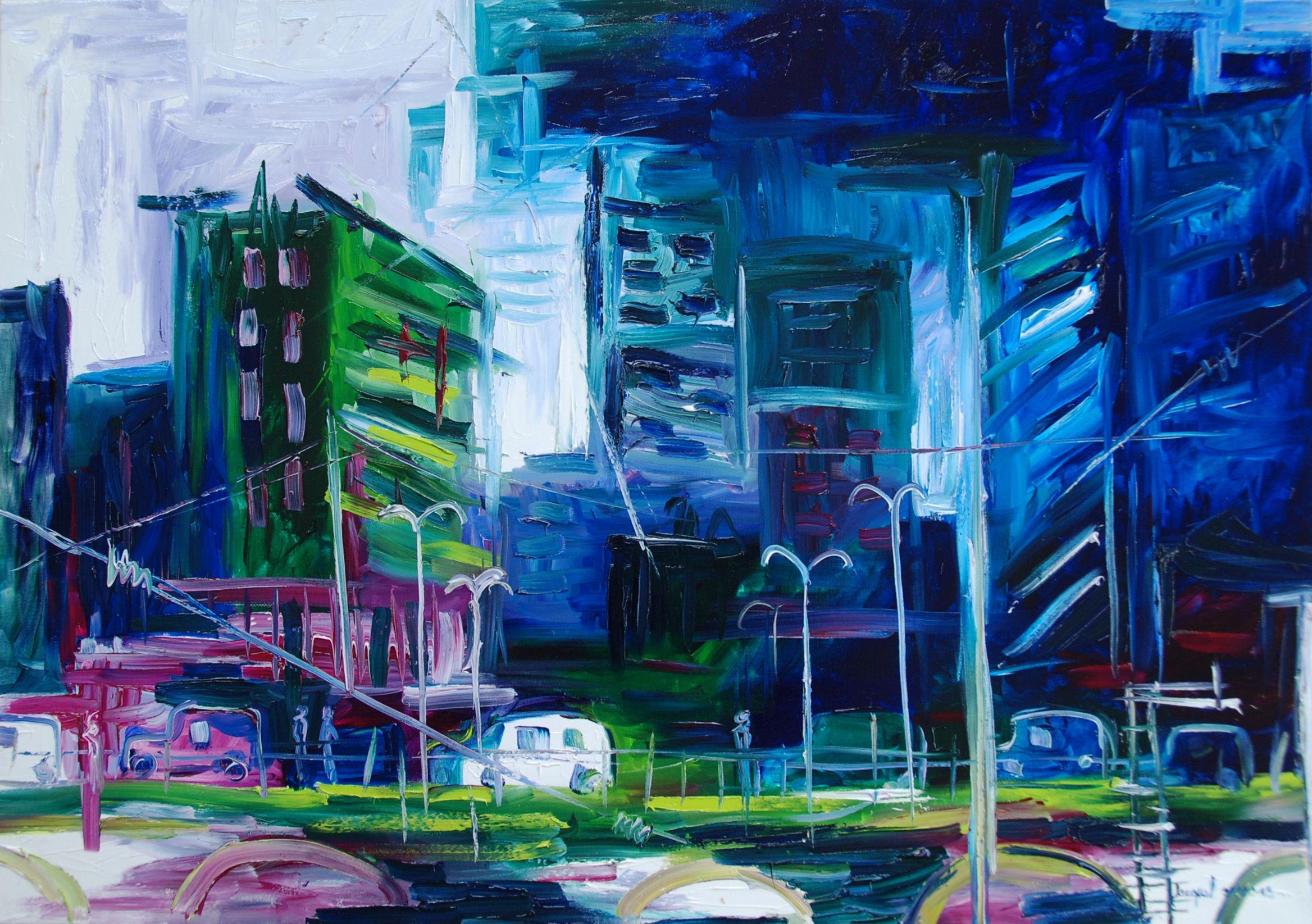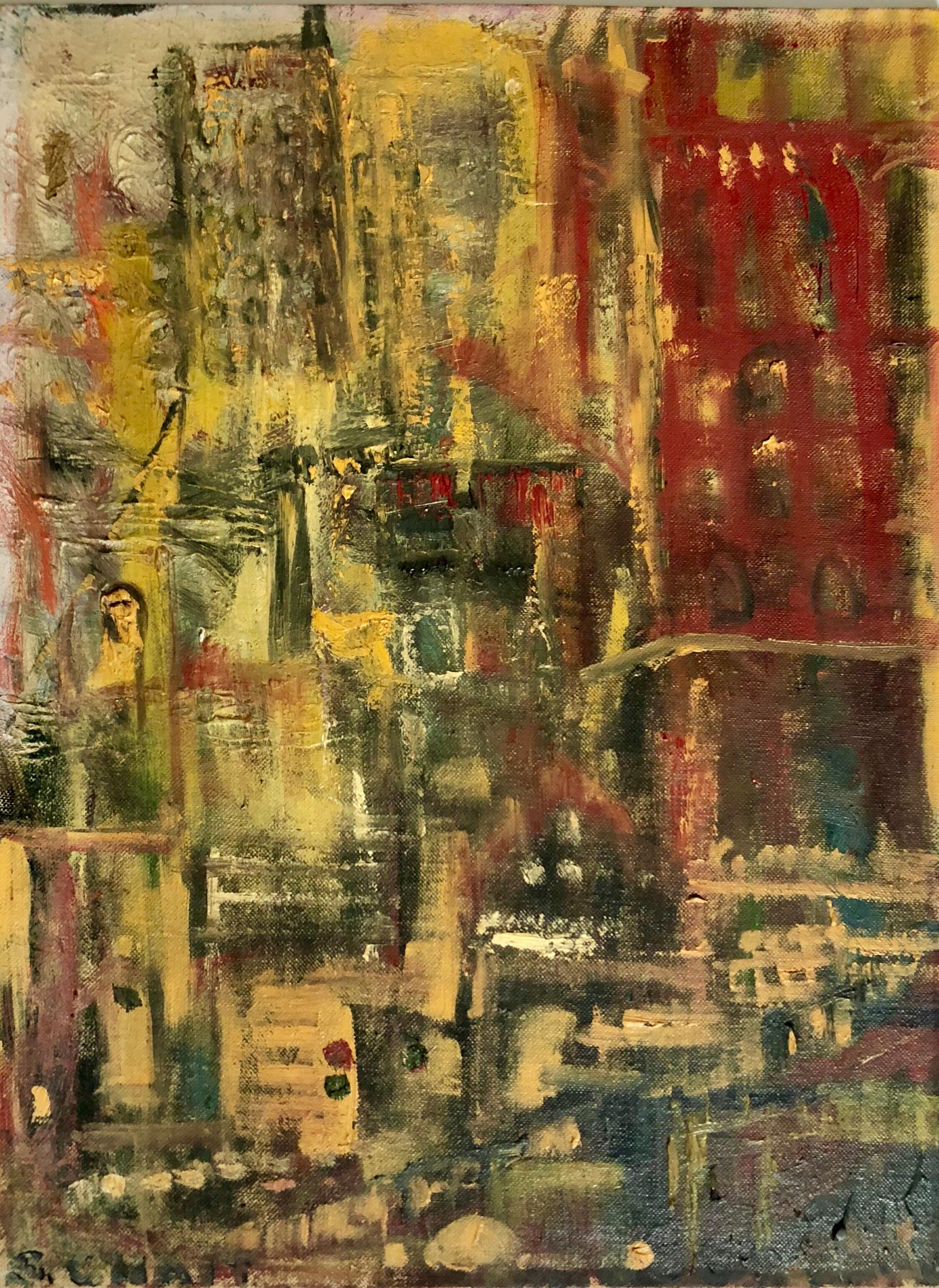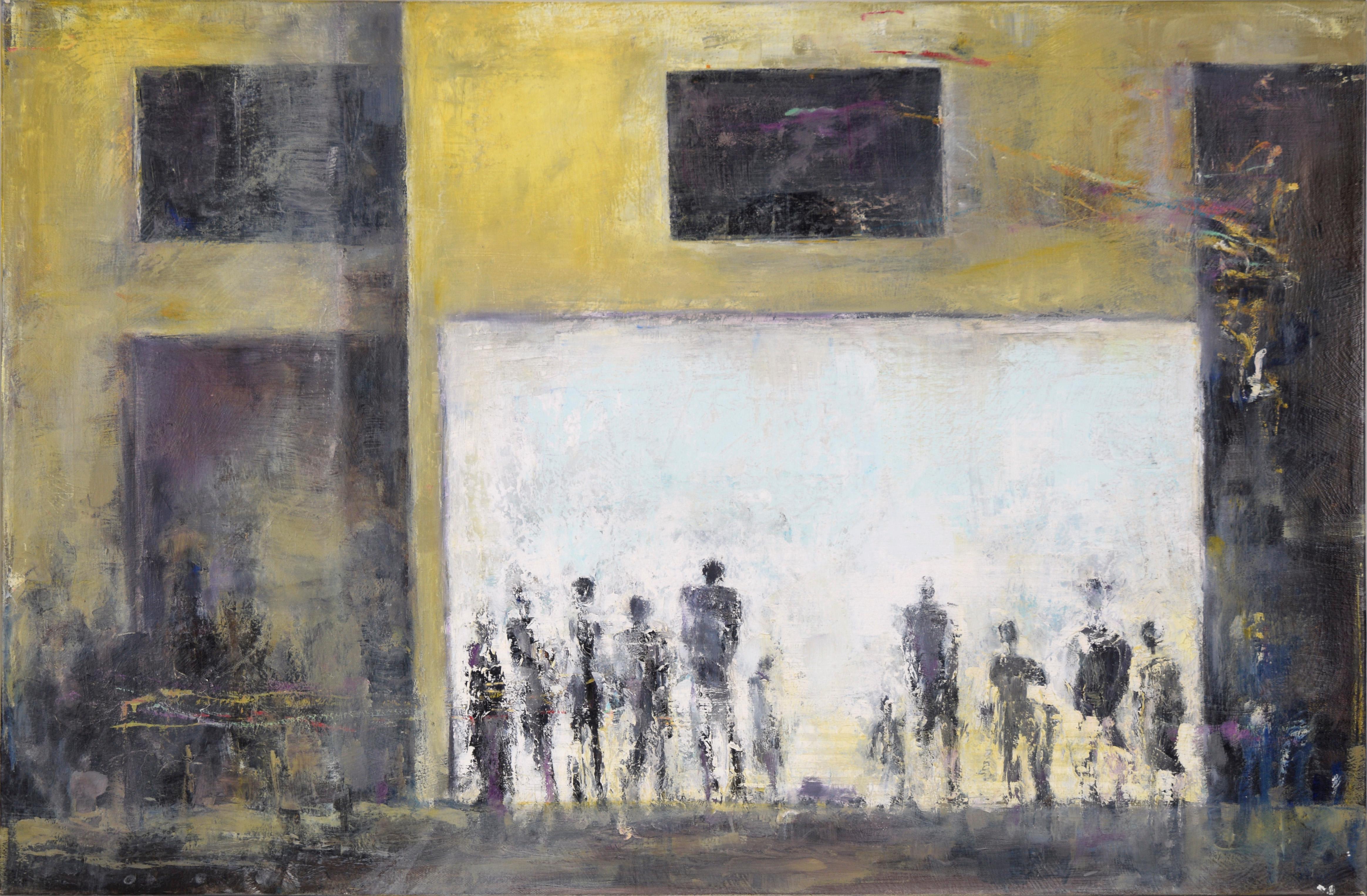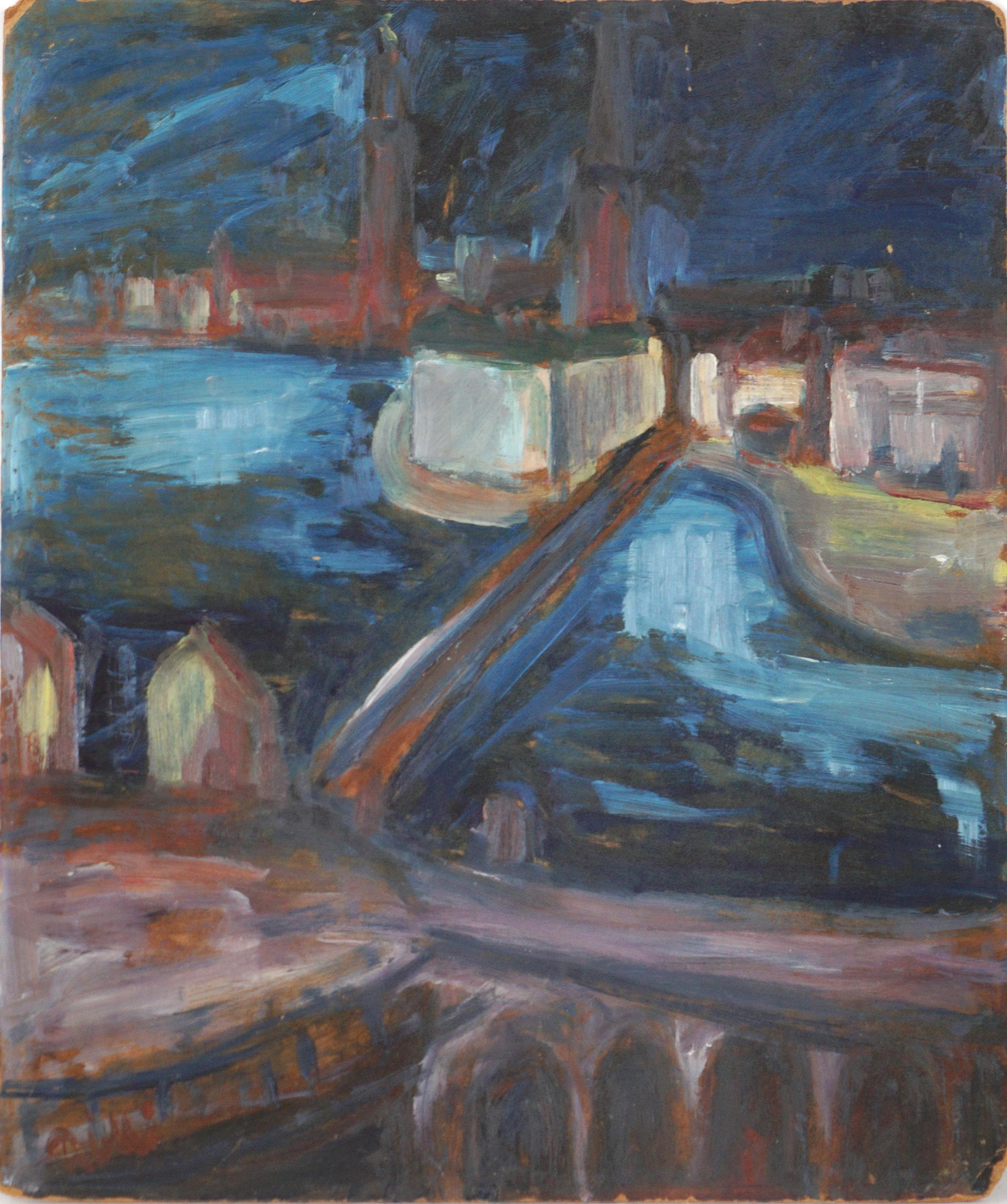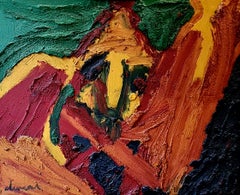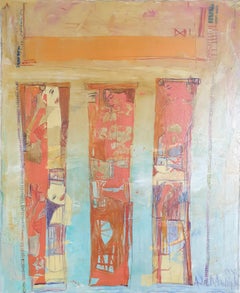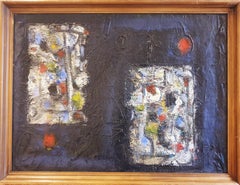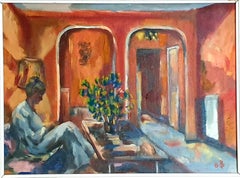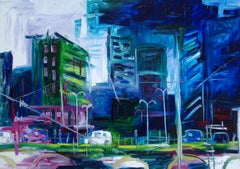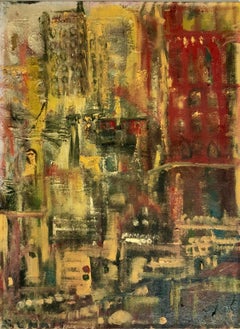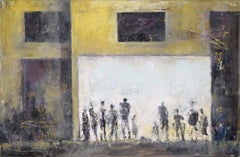Items Similar to Large Expressionist Oil on Canvas, Apartment Interior and Cityscape. Oil.
Video Loading
Want more images or videos?
Request additional images or videos from the seller
1 of 25
Large Expressionist Oil on Canvas, Apartment Interior and Cityscape. Oil.
$2,237.17
$2,796.4620% Off
£1,687.23
£2,109.0420% Off
€1,920
€2,40020% Off
CA$3,093.08
CA$3,866.3520% Off
A$3,464.77
A$4,330.9620% Off
CHF 1,819.82
CHF 2,274.7820% Off
MX$42,130.50
MX$52,663.1320% Off
NOK 23,044.90
NOK 28,806.1320% Off
SEK 21,875.81
SEK 27,344.7620% Off
DKK 14,616.30
DKK 18,270.3720% Off
About the Item
A mid century Expressionist oil on canvas of a man, child and cat in an interior with a cityscape beyond. The work is not signed but there are various notations to the top rear stretcher, 'Mazilier OP 1 94'. This could refer to the artist or the subject. It could also be a title and exhibition number. A mystery yet to be solved.
It is an intriguing composition reflecting on the Expressionist movements fascination with the alienation of the individual within the city. A highly colourful painting full of energy, imparted to the picture by the thickly applied textured paint creating ripples and shapes and the deep but vibrant colours.
A moody late evening vibe is created by the artist through a choice of warm, deep colours. The smouldering red sun reflected in the television screen sits over the cityscape casting long shadows into the apartment. The artist continues this sense of evening shadow by elongating the male figure, television and door, creating a deep contrast with the small figure of the girl and the tiny clock squashed above the door.
There is balance and control in the composition through both colour and form. The red of the circular sun is balanced across the image in the television screen and the red of the girl's hair and in the circle of the clock above the door, the door and window relate to one another as do the white oblong of the skyscrapers which are echoed in the elongated white coat of the male figure. The shapes and the colours communicate as do the three faces in the painting all looking out to the viewer communicating with us. This is an intimate scene which invites the viewer in and even awaits their participation to bring it alive, a snapshot waiting to be unfrozen.
An intriguing painting of many levels which keeps the eye engaged by its mastery of shape perspective texture and colour.
The arrival of Expressionism announced new standards in the creation and judgment of art. Art was now meant to come forth from within the artist, rather than from a depiction of the external visual world, and the standard for assessing the quality of a work of art became the character of the artist's feelings rather than an analysis of the composition.
Expressionist artists often employed swirling, swaying, and exaggeratedly executed brushstrokes in the depiction of their subjects. These techniques were meant to convey the turgid emotional state of the artist reacting to the anxieties of the modern world.
Through their confrontation with the urban world of the early-20th century, Expressionist artists developed a powerful mode of social criticism in their serpentine figural renderings and bold colours. Their representations of the modern city included alienated individuals - a psychological by-product of recent urbanization - who were used to comment on capitalism's role in the emotional distancing of individuals within cities.
- Dimensions:Height: 28.75 in (73 cm)Width: 39.38 in (100 cm)Depth: 0.79 in (2 cm)
- Medium:
- Movement & Style:
- After:Ernst Ludwig Kirchner (1880-1938, German)
- Period:
- Condition:
- Gallery Location:Cotignac, FR
- Reference Number:Seller: LG/CityApartment1stDibs: LU1430213626452
About the Seller
5.0
Platinum Seller
Premium sellers with a 4.7+ rating and 24-hour response times
Established in 2000
1stDibs seller since 2020
249 sales on 1stDibs
Typical response time: <1 hour
- ShippingRetrieving quote...Shipping from: Cotignac, France
- Return Policy
Authenticity Guarantee
In the unlikely event there’s an issue with an item’s authenticity, contact us within 1 year for a full refund. DetailsMoney-Back Guarantee
If your item is not as described, is damaged in transit, or does not arrive, contact us within 7 days for a full refund. Details24-Hour Cancellation
You have a 24-hour grace period in which to reconsider your purchase, with no questions asked.Vetted Professional Sellers
Our world-class sellers must adhere to strict standards for service and quality, maintaining the integrity of our listings.Price-Match Guarantee
If you find that a seller listed the same item for a lower price elsewhere, we’ll match it.Trusted Global Delivery
Our best-in-class carrier network provides specialized shipping options worldwide, including custom delivery.More From This Seller
View AllAbstract Expressionist Abstract Large Oil on Canvas, Le Pèlerin.
Located in Cotignac, FR
Expressionist abstract oil on canvas by French artist Bernard Duvert. The painting is signed bottom left, dated and titled to the rear stretchers and with exhibition numbers.
A magn...
Category
Late 20th Century Neo-Expressionist Abstract Paintings
Materials
Canvas, Oil
$4,474 Sale Price
20% Off
French Mixed Media Abstract on Canvas.
Located in Cotignac, FR
Colourful, French mixed media abstract, acrylic, newsprint and ink from the 1980s. The canvas is signed and dated bottom right but we have not yet managed to decipher it.
A colourful and engaging painting crossing over styles. The colourfield elements are reminiscent of the work of Mark Rothko, three defined bands of colour in orange/pink tones vertically dissecting the painting with one horizontal band across the top, and yet the elongated depiction of the female figures within the bands remind us of Gustav Klimt and his paintings of Adele.
The background of the painting has been worked broadly with a palette knife whilst the detail has been added quickly and deftly with ink or finer brushstrokes. With the addition of newsprint (in French) the artist may...
Category
Late 20th Century Abstract Expressionist Mixed Media
Materials
Canvas, Acrylic, Newsprint, Ink
'Monogrammes'. French Mid-Century Abstract Expressionist. Oil on Canvas.
Located in Cotignac, FR
A mid-century abstract expressionist oil on canvas presented in a plain wooden frame. The work is titled and there are initials 'G.O.' (artist?) on a label to the rear stretcher as w...
Category
Mid-20th Century Contemporary Abstract Paintings
Materials
Canvas, Oil
Late Mid Century Interior Scene, A Villa at Cannes, South of France. Oil, Board
Located in Cotignac, FR
Late 20th century oil on board of an interior scene with seated female figure by Bill Brown. Initial signed and dated 76 bottom right and titled to the reve...
Category
1970s Modern Figurative Paintings
Materials
Oil, Board
Contemporary Italian Abstract Expressionist Oil on Canvas.
Located in Cotignac, FR
Contemporary Abstract Expressionist acrylic and oil on canvas by Italian artist Albino Palamara. Signed to the reverse. Title: Espoir de la Rencontre.
A strikingly colourful and en...
Category
21st Century and Contemporary Contemporary Abstract Paintings
Materials
Acrylic, Canvas, Oil
Mid Century French Expressionist Oil, La Couseuse
Located in Cotignac, FR
A mid-century French Expressionist oil on paper, laid on board, painting of a lady sewing by Raphael Arnal. The painting is signed bottom left and dated, located and attributed to th...
Category
Mid-20th Century Expressionist Figurative Paintings
Materials
Oil
You May Also Like
Original oil painting of a modern city, Painting, Oil on Canvas
By Christine Jacquel
Located in Yardley, PA
Original oil painting of a modern city. It is an oil painting painted with spontaneous, firm and energetic traits with bright colors. It's a modern representation of a bridge with ca...
Category
2010s Modern Paintings
Materials
Oil
Original oil painting of a modern city, Painting, Oil on Canvas
By Christine Jacquel
Located in Yardley, PA
Original oil painting of a modern city. It is an oil painting painted with spontaneous, firm and energetic traits with bright colors. It's a modern representation of a bridge with ca...
Category
2010s Modern Paintings
Materials
Oil
Abstract Cityscape 1960 Oil Painting Signed Chait Expressionist NYC City Scene
Located in Surfside, FL
This is a bold, abstracted city scene. It appears to be New York City, It could be any large metropolis with skyscrapers and a bustle to it. It is signed S. Chait and signed with ini...
Category
1960s Abstract Abstract Paintings
Materials
Oil, Board
Waiting - Abstracted Urban Landscape with Figures in Acrylic on Canvas
Located in Soquel, CA
Waiting - Abstracted Urban Landscape with Figures in Acrylic on Canvas
Urban landscape by an unknown artist (20th Century). There are several figures standing under what appears to ...
Category
21st Century and Contemporary American Realist Landscape Paintings
Materials
Canvas, Acrylic, Stretcher Bars
Mid Century Abstract Expressionist Cityscape
Located in Soquel, CA
Wonderful mid century abstract expressionist landscape of bridge over water cityscape, circa 1960. Illegible signature lower left ("Aioli"?). Conditi...
Category
1960s Abstract Expressionist Abstract Paintings
Materials
Masonite, Oil
City 7. Abstract original painting
Located in Zofingen, AG
In creating this piece, I poured my soul into a dance of colors and forms. Utilizing acrylics, oils, and colored pencils, I embraced abstract expressionism to capture the bustling en...
Category
2010s Abstract Impressionist Interior Paintings
Materials
Canvas, Acrylic
More Ways To Browse
Girl Cat Painting
Screen Doors Vintage
Long Evening Coat
Vintage Oil Clock
Squash Painting
Taiwan Wood
Oil Painting Resting Woman
Woman With Cat Painting
19th Century Orientalist Paintings
Ballerina Paintings
Diego Rivera Painting
Fish Market
Holy Family Painting
Madeleine Paris
Painting With Face Profile
Winged Woman
French Orientalist Paintings
Macabre Art
